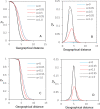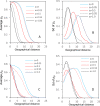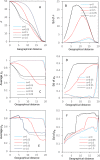The wave of gene advance under diverse systems of mating
- PMID: 32606419
- PMCID: PMC7490428
- DOI: 10.1038/s41437-020-0333-9
The wave of gene advance under diverse systems of mating
Abstract
Mating systems will influence gene spread across the natural distribution of a plant species. Existing theories have not fully explored the role of mating systems on the wave of advance of an advantageous gene. Here, we develop a theory to account for the rate of spread of both advantageous and neutral genes under different mating systems, based on migration-selection processes. We show that a complex relationship exists between selfing rate and the speed of gene spread. The interaction of selfing with gametophytic selection shapes the traveling wave of the advantageous gene. Selfing can impede (or enhance) the spread of an advantageous gene in the presence (or absence) of gametophytic selection. The interaction of selfing with recombination shapes the spread of a neutral gene. Linkage disequilibrium, mainly generated by selfing, enhances the traveling wave of the neutral gene that is tightly linked with the selective gene. Recombination gradually breaks down the genetic hitchhiking effects along the direction of advantageous gene spread, yielding decreasing waves of advance of neutral genes. The stochastic process does not alter the pattern of selfing effects except for increasing the uncertainty of the waves of advance of both advantageous and neutral genes. This theory helps us to explain how mating systems act as a barrier to spread of adaptive and neutral genes, and to interpret species cohesion maintained by a low level of adaptive gene flow.
Conflict of interest statement
The authors declare that they have no conflict of interest.
Figures








Similar articles
-
Mating system as a barrier to gene flow.Evolution. 2015 May;69(5):1158-77. doi: 10.1111/evo.12660. Epub 2015 May 7. Evolution. 2015. PMID: 25873333
-
Mating system shifts a species' range.Evolution. 2019 Feb;73(2):158-174. doi: 10.1111/evo.13663. Epub 2019 Jan 7. Evolution. 2019. PMID: 30592527
-
Mating system and the critical migration rate for swamping selection.Genet Res (Camb). 2011 Jun;93(3):233-54. doi: 10.1017/S0016672311000127. Epub 2011 May 6. Genet Res (Camb). 2011. PMID: 21554777
-
The selfing syndrome and beyond: diverse evolutionary consequences of mating system transitions in plants.Philos Trans R Soc Lond B Biol Sci. 2022 Jul 18;377(1855):20200510. doi: 10.1098/rstb.2020.0510. Epub 2022 May 30. Philos Trans R Soc Lond B Biol Sci. 2022. PMID: 35634918 Free PMC article. Review.
-
On the evolution of genetic incompatibility systems. VI. A three-locus modifier model for the origin of gametophytic self-incompatibility.Genetics. 1991 Jun;128(2):453-69. doi: 10.1093/genetics/128.2.453. Genetics. 1991. PMID: 2071024 Free PMC article. Review.
References
-
- Barrett SCH. Evolution of mating systems: outcrossing versus selfing. In: Losos J, editor. The Princeton guide to evolution. Princeton, NJ: Princeton University Press; 2014. pp. 356–362.
-
- Barton NH. Gene flow past a cline. Heredity. 1979;43:333–340.
-
- Barton NH, Bengtsson BO. The barrier to genetic exchange between hybridizing populations. Heredity. 1986;57:357–376. - PubMed
Publication types
MeSH terms
Associated data
LinkOut - more resources
Full Text Sources

